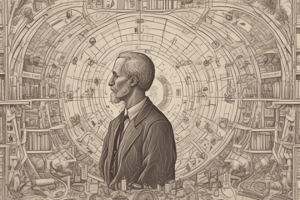Podcast
Questions and Answers
Which of the following best describes the role of mutual understanding and collective effort in an organization?
Which of the following best describes the role of mutual understanding and collective effort in an organization?
- They are discouraged to maintain a structured and efficient workflow.
- They are secondary to individual achievements within the organization.
- They are important only in informal organizations, not formal ones.
- They form the foundational basis upon which the organization is built. (correct)
How do organizations generally respond to changes in their environment or internal structure?
How do organizations generally respond to changes in their environment or internal structure?
- By adapting and modifying their structure, functions, and methodologies. (correct)
- By strictly adhering to established protocols without deviation.
- By disregarding external factors and focusing solely on internal efficiency.
- By minimizing collaboration to prevent disruption during transitions.
Considering Chester Barnard's definition, what is the key element that constitutes an organization?
Considering Chester Barnard's definition, what is the key element that constitutes an organization?
- A system of consciously coordinated activities or forces of two or more persons. (correct)
- A structure that prioritizes individual recognition over collective achievement.
- A rigid hierarchy that dictates all actions and communications.
- A collection of individuals working independently towards their own goals.
Which aspect is most crucial for organizations to maintain employee engagement and accountability?
Which aspect is most crucial for organizations to maintain employee engagement and accountability?
What is the significance of effective policy-making, planning, and implementation in organizational effectiveness?
What is the significance of effective policy-making, planning, and implementation in organizational effectiveness?
Why is it important for organizations to be viewed as planned activities?
Why is it important for organizations to be viewed as planned activities?
What is the primary basis for categorizing organizations as either formal or informal?
What is the primary basis for categorizing organizations as either formal or informal?
Why is legal legitimacy important for formal organizations?
Why is legal legitimacy important for formal organizations?
Which characteristic distinguishes formal organizations, emphasizing protocol adherence over personal preferences?
Which characteristic distinguishes formal organizations, emphasizing protocol adherence over personal preferences?
What guides the operation of a formal organization, ensuring all activities align with its strategic objectives?
What guides the operation of a formal organization, ensuring all activities align with its strategic objectives?
How do formal organizations contribute to societal structure and advancement?
How do formal organizations contribute to societal structure and advancement?
Which of the following is a key aspect of how tasks are managed within formal organizations?
Which of the following is a key aspect of how tasks are managed within formal organizations?
What is the origin of informal organizations within a company or group setting?
What is the origin of informal organizations within a company or group setting?
What is the primary source of authority and leadership within informal organizations?
What is the primary source of authority and leadership within informal organizations?
How do informal organizations primarily maintain cohesion and ensure conformity to group norms?
How do informal organizations primarily maintain cohesion and ensure conformity to group norms?
How do informal organizations function in relation to formal organizational structures?
How do informal organizations function in relation to formal organizational structures?
What is the significance of membership choice and personal connection in informal organizations?
What is the significance of membership choice and personal connection in informal organizations?
What role do informal organizations play in information dissemination and communication within a company?
What role do informal organizations play in information dissemination and communication within a company?
What is the overarching benefit of blending formal structures with informal networks within an organization?
What is the overarching benefit of blending formal structures with informal networks within an organization?
What is a key management takeaway regarding organizational structure?
What is a key management takeaway regarding organizational structure?
Flashcards
Organization
Organization
A system involving systems, technology, and ideas built on mutual understanding and collective effort.
Organizational Structures
Organizational Structures
Human structures designed to achieve specific goals efficiently, often involving task division and coordination.
Organization (Chester Barnard's Definition)
Organization (Chester Barnard's Definition)
A system of consciously coordinated activities or forces of two or more persons.
Types of Organizations
Types of Organizations
Signup and view all the flashcards
Organizational Effectiveness
Organizational Effectiveness
Signup and view all the flashcards
Formal Organizations
Formal Organizations
Signup and view all the flashcards
Characteristics of Formal Organizations
Characteristics of Formal Organizations
Signup and view all the flashcards
Importance of Formal Organizations
Importance of Formal Organizations
Signup and view all the flashcards
Informal Organizations
Informal Organizations
Signup and view all the flashcards
Characteristics of Informal Organizations
Characteristics of Informal Organizations
Signup and view all the flashcards
Functions of Informal Organizations
Functions of Informal Organizations
Signup and view all the flashcards
Study Notes
Introduction to Organizations
- This lecture introduces the concept of organizations within the context of Dr. Babasaheb Ambedkar Open University.
- The discussion includes the definition, types, characteristics, and importance of organizations.
What is an Organization?
- An organization involves systems, technology, and ideas, requiring precision, principles, and modifications.
- Organizations are encountered daily through entities like municipalities, post offices, and government offices.
- They are built on a foundation of mutual understanding and collective effort among members.
Defining Characteristics of Organizations
- Individuals are a crucial component, and collaboration is essential for success.
- Organizations adapt and evolve their structure, functions, and methodologies over time.
- Organizations function as a family, emphasizing the importance of unity and mutual assistance.
Organizational Structures
- The industrial revolution led to the rise of factories and production centers.
- A common definition describes organizations as human structures designed to achieve specific goals efficiently.
Key Definitions by Scholars
- Chester Barnard: Defines an organization as a system of consciously coordinated activities or forces of two or more persons.
- Another Scholar: Views an organization as a structure where tasks are divided and coordinated among individuals to achieve a common goal.
- A Scholar Named Pensioner: Highlights that in an organization, work is systematically divided, and relationships between individuals and groups are formed.
Types of Organizations
- Various types exist, including community groups, women's associations, youth welfare associations, and more.
- Organizations require employee engagement and accountability within a hierarchical structure.
Factors Influencing Organizational Effectiveness
- Effective policy-making, planning, and implementation are crucial.
- Suitable program development and widespread engagement contribute to success.
- Organizations greatly influence personal lives, directly or indirectly.
- Examples of different types of organizations include schools and the extensive Indian Railways.
Forms of Organizations
- Span across governmental, non-governmental, educational, social, and religious sectors.
- Include business organizations.
- Fundamentally, an organization is a planned activity aimed at achieving specific goals through collaborative efforts.
Types of Organizations
- Organizations are categorized as formal or informal.
Formal Organizations
- Arise from structured and deliberate planning and are governed by specific regulations.
- These affect conduct and interactions within the organization.
- According to Srail and other scholars, formal organizations are characterized by written rules and systems.
- Have structured departments and hierarchies.
Characteristics of Formal Organizations
- Legal Legitimacy: Formal organizations are established with governmental approval at various levels.
- Established Structure: Feature clear hierarchies with defined roles and responsibilities.
- Stability: Created with long-term sustainability.
- Emphasis on Rules: Focus on following protocols over personal preferences.
- Task-Oriented Operate based on defined job roles.
- Separation of Personal from Organizational Conduct: Uphold integrity by preventing any actions conflicting with the organization’s purpose.
- Adherence to Hierarchy: Function according to a predetermined structure.
How Formal Organizations Function
- Tasks are clearly defined and assigned.
- New policies are implemented as needed.
- Work is distributed according to defined roles and capabilities.
- Activities are geared toward strategic, intended outcomes.
Importance of Formal Organizations
- These organizations are essential for society’s structure and advancement.
- Different segments of them are useful in varying functions and tactics.
- Essential in structuring effective governance which guide work.
- They act according to predetermined ideas.
Informal Organizations
- Emerge naturally from the interactions and connections among employees and other members.
- The composition includes groups and interactions.
- Stem from social needs
- Often are referred to as "grapevines."
Characteristics of Informal Organizations
- Emerge through shared ideologies.
- Maintain cohesion through ongoing interaction.
- Promote behavioral conformity and norms.
- Leadership and decision-making are decentralized.
- Authority is derived from acceptance.
- Membership is often based on choice and personal connection.
Functions of Informal Organizations
- Facilitate communication and information dissemination.
- Foster social connections and relationships.
- Offer avenues for influence and empowerment.
- Help to achieve unity in the organization.
How Informal Organizations Operate
- Can complement formal organizations by enhancing communication and engagement.
- Their strength and ability to support one another.
- The blend of these organizations enhances member fulfillment.
Conclusion
- The lecture summarizes by emphasizing that combining formal structures and informal networks is important.
- Also important is understanding the key differences and functions of these types.
- Involves important terms relating to organization.
Studying That Suits You
Use AI to generate personalized quizzes and flashcards to suit your learning preferences.




